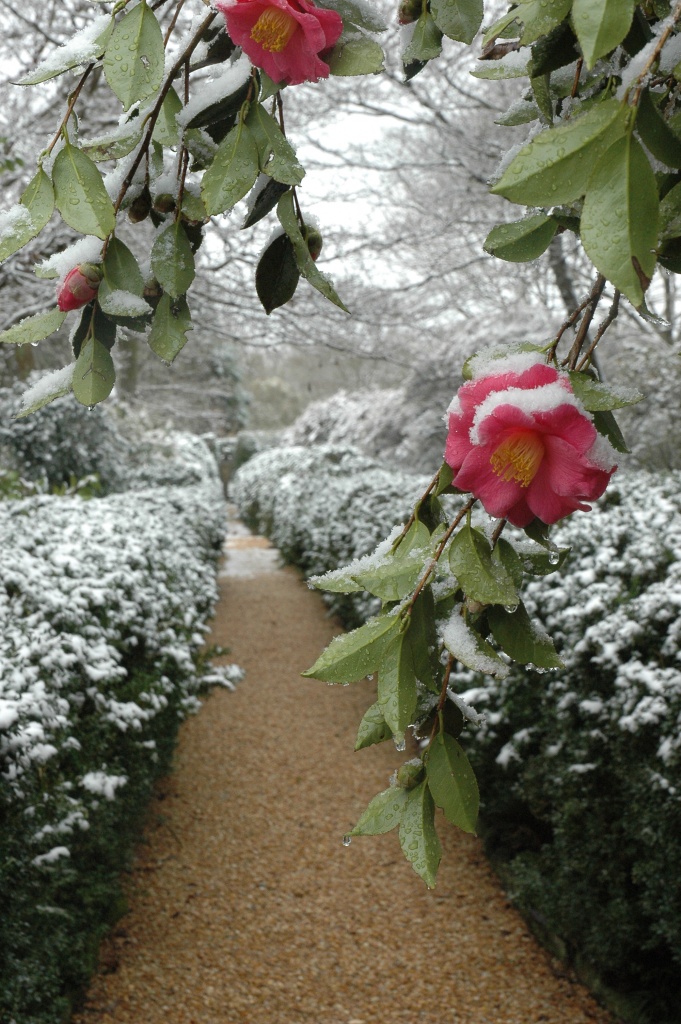Winter’s Rose

Imagine strolling the paths of a classic southern garden on a typically mild winter’s day. As you round a curve, a large, glossy-leaved, evergreen shrub covered in exquisite, fist-sized flowers comes into view. Would more details be needed before you identified this audacious cold-weather bloomer as a camellia, or was that the easy choice?
While native to eastern and southern Asia, camellias have become indelibly sealed into the southern gardener’s psyche since their introduction here in the late 1700s, thanks to their beauty and relative ease of culture in our temperate climate. Surprisingly, of the 200 or so species distributed over their native lands only a fraction are cultivated in U.S. gardens, the most popular being C. japonica, with C. sasanqua, sinensis and four or so others rounding out the list.
However, that does not mean that the choices for planting are meager, as from those few have come many thousands of cultivated varieties (or cultivars) to choose from.
We aren’t certain if Sarah Ferrell, the woman who established the antebellum garden at Hills & Dales, had japonicas
in her intricate landscape, but we suspect she did, for they were definitely available to 19th century gardeners. We do know that she grew the camellia with the most economic importance and fame world-wide, namely the tea plant—C. sinensis. If you weren’t aware that the tea you drink comes from the leaves of a camellia species, don’t think that you’re alone. Hedges of tea still thrive at the estate, and although handsome, they blend in with the rest of the shrubbery and usually go unnoticed unless we get the opportunity to reveal their true identity to garden guests. Most are a bit amazed.
After Fuller Callaway Sr. acquired the Ferrell estate, it is certain that his wife, Ida, grew japonicas because they’re mentioned in several pieces written about the garden during that time; no record of which cultivars she chose has been found, though. Her daughter-in-law, Alice, added many more during the years she directed the garden’s care and also detailed the name, number, location and date planted for each kind. From the 1940s through the mid-1970s, over forty different japonicas are listed, along with two sasanquas; most are still thriving in the garden now, decades after they were planted. The losses are noted as well, along with the date; almost all occurred during the winter of 1984, when a low temperature of -9° F was recorded here. Six cultivars didn’t survive that extreme cold, but most of those were losses of one or two plants. Ironically, ‘Dixie,’ the one with the highest number in the landscape was among those. All thirty-six were killed, including twenty-nine that formed a hedge on the garden terrace adjacent to the house. It was still necessary to severely prune back many that lived at winter’s end because of injury from the bitter freeze, but they grew back as large and resplendent as ever, a testament to their toughness and the old adage about time healing wounds.
Alice Callaway’s camellia list reads like an excerpt from a “Who’s Who” among heirloom japonicas‒ ‘Alba Superba,’ ‘Debutante,’ ‘Empress,’ ‘High Hat,’ ‘Pink Perfection,’ and ‘Ville de Nantes’ are a sampling from it, a noble collection still faithfully performing their annual prelude to spring. Consider yourself invited to come stroll through our garden in reality this winter and catch some of the show.
-JP

A sample of camellia varieties cultivated at the estate.
View this entire Portico Newsletter: